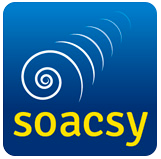Frequently asked questions
Lateral sonars and multi-beam sounders when operating in imaging mode, provide images of the recorded backscatter of acoustic impulses from the sea floor. Their broad swathes allow for rapid and precise imaging of wrecks or other objects lying on the sea floor. They cannot however gather information on the sub-surface.
To explore the sub-surface a variety of technologies can be employed, such as sub-bottom profilers, sparkers or boomer systems. These single beam acoustic systems measure arrivals reflected from the sea floor and sub-surface reflectors. They provide vertical slices through the sub-surface oriented in the direction of acquisition (seismograms).
Originally conceived to allow the study of sub-surface stratigraphy, they generally have weak directivity and are unable to localize the contacts in the planar direction. On the opposite, with high directivity systems like Parametric sub-bottom profilers, a complete coverage of the seabed requires numerous closely – spaced traverses (and a lot of re-runs to consider navigation inaccuracy). This is time – consuming, expensive, and technically challenging.
The seaCHIRP™ technoloy is innovative in that it generate 3D images with meter to decimeter scale resolution of the recorded backscattered energy and /or very high-resolution central 2D seismogram of specular reflections.
Thus, the seaCHIRP™ samples the two types of returning energy, specular and diffuse, and its large swathe and broad impulse frequency band allows a comprehensive, rapid and precise evaluation of the sub-surface.
Magnetometers detect magnetic anomalies beneath the seafloor, but the dimensions of detected objects are difficult to determine. Correct positioning of these objects requires numerous closely – spaced traverses. Non-magnetic geohazards are not identified.
seaCHIRP™’s unique 4.5 octave bandwidth, from 0.5 KHz to 10 KHz confers the following advantages to our clients:
- High vertical resolution and deep penetration
- Improved signal / noise ratio (that improves detection and positioning performance)
- Significantly greater input CHIRP customization and optimization capability. The energy frequency distribution can be precisely controlled, i.e. concentrated in the low frequencies for improved, deeper lithological response and less noisy data vs concentrated in the high frequencies for improved detection of small shallow objects.
- Low frequencies result in greater penetration depth, and better lithology response.
As mentioned, the high degree of flexibility built into the seaCHIRP™ system grants enormous control over survey design and therefore optimization:
- The number of beams / channels can be optimized on the seaCHIRP™3D system. High number of beams → more precise location of small reflectors; low number of beams → smaller dataset, faster processing.
- The firing rate can be selected for optimum results, within a range of 0.075 – 0.2 seconds. This will affect dataset size and is typically modified to account for surveying speed, and predicted target size.
- From an operational standpoint, the towed bird has been attached to the side, rear and underside of available vessels, as well as being towed behind them.
This is a critical value, contingent on a wide variety of survey parameters, water depth, depth of burial, geology etc. For example, we would anticipate that in water depths of 20 m, the seaCHIRP™3D system could detect a 1 m diameter sphere buried under 4 m of sand (1 dB / λ attenuation). Please see the ‘Approximate Achievable Resolutions’ datasheet for further information.
As the seaCHIRP™ systems are currently surface tow systems, water depth is a limiting factor on data quality. Owing to the high energy content of the input pulse however, surveying in water depths up to 50 m has been successfully carried out.
The seaCHIRP™ towed bird is compact and rugged, with a low hydrographic profile. It has been successfully deployed at speeds of 5 knots, with wave heights of up to 1 m. The high survey speed not only allows for shorter acquisition times, but has also allowed the seaCHIRP™ to be deployed in conjunction with towed fish that require a minimum speed to remain stable.
The seaLOGS software outputs ASCII and standard SEGY format 2D and 3D datasets. The data is zero phase, and conventional SEGY polarity.
The exceptionally broad swath of the seaCHIRP™3D system allows for wide spacing between survey lines, thus saving both time and money. The survey line spacing is clearly water depth dependent. During a recent survey, a line separation of 12.5 m was sufficient for the acquisition of very high quality data in 30 m water depth.
This is certainly possible, particularly where 24 hour surveying is a requirement.
We at SOACSY are certainly open to discussion of the possibility of long-term leasing if this is a requirement.
Downloads
seaCHIRP™3D
seaCHIRP™2D
Key track records

